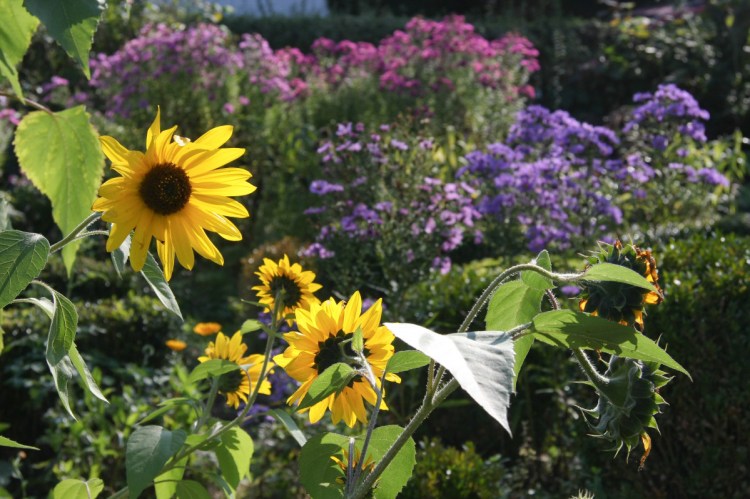Editor’s Note: This is the second of a two-part series on rejuvenating an abandoned garden.
Hard work always merits a reward. After an overgrown or abandoned garden has been cleaned up – a task I wrote about last week – it is time to create the new version of that garden.
This job is a pleasure, because to me, nothing is more enjoyable than buying plants – knowing you have space for them – and then figuring out how best to arrange them in that space.
Any small trees, shrubs or perennials that were saved will serve as the framework for the renovated garden. Those plants, say, a huge PeeGee hydrangea, a big common lilac that needs a bit of renovation, a large rhododendron or a bridal wreath spirea, have size and a bit of history, so they may end up as the centerpiece of your reclaimed garden.

If you didn’t rescue such a plant, buy at least one dramatic, large plant to serve as the centerpiece of your garden.
Next, plant bulbs – lots of them. If deer are regular visitors, avoid tulips – which deer and some rodents love to eat. Most others are a go. Plant crocus, daffodils, alliums, fritillaria, camassia, trying to get early, mid- and late-season varieties of the plants.
One of the beauties (pun definitely intended) of bulb plants is that they can be planted right next to any other plants in the garden. It does no harm if the shoots go up through other perennials or small shrubs. It gives a full, grandmother’s cottage look to the garden.
Figure out the vantage point from which people will most often look at the garden. In general, taller plants should go in the back, short ones in the front and mid-level plants in between.
Exceptions exist (they always do): Some tall see-through plants are perfect in the middle of the garden. For example, Cimicifuga racemosa, a Maine native with the common name bugbane, can grow 7 feet tall and its spikelike flowers are thin enough not to block the view of any plants behind it.
Tall shrubs should go in the back. Lately, I favor physocarpus (ninebark) and viburnums, both of which can be native, depending on the variety. Shorter shrubs that will suit are mountain laurel, sheep laurel and clethra.
Plant your restored garden so that something is in bloom at all times. A few decades ago, homeowners did this for the selfish reason that they wanted continuous color for their own pleasure. Now the idea is to provide flowering plants for pollinators all gardening season long. It’s nice to think that something you do because it is enjoyable can also be good for the world.
It’s good to plant native plants, but they needn’t all be natives. Since the garden you are renovating was probably several decades old, chances are good it has some imports. For example, I think a typical cottage garden needs peonies. Yes, they’re native to the Mediterranean and Asia, not Maine, but they are beautiful and are definitely not invasive. They bloom from midspring to early summer in white, pink and red. They’re traditional and last seemingly forever in a garden.
In addition, I think every proper Maine garden should have some irises, daylilies (in addition to any you rescued, which are probably the tiger lily that can sometimes escape gardens and grow wild), astilbe and phlox.
Native plants to consider include asclepias, because monarch butterflies – which are under consideration for listing as endangered – need the plant to lay their eggs and for the caterpillars to feed. My favorite is swamp milkweed, Asclepias incarnata, which is doing well in our garden. Asclepias tuberosa is also well-behaved.
No Maine garden would be complete without rudbeckia (black-eyed Susan) and echinacea (coneflower.) I also love the look of Joe Pye weed, but – fair warning – it will try to overwhelm its neighbors.
These are just suggestions, plants that I like. It is your garden, and the choices are up to you. Grow some from seed if you want, and tour garden centers – but be sure you do so at different times of year. Shoppers typically buy what is in bloom, so if you shop only in spring, your garden will be limited to spring bloomers.
Once the garden is planted, water thoroughly and then mulch with a couple of inches of natural bark mulch.
This mulch is a temporary feature of the garden. The shrubs and perennials are baby plants that will grow wider over the years, reaching out to touch the plants that are beside them. Until that happens, the mulch will help prevent random weeds from seeding themselves and destroying the garden you have carefully designed.
Then sit back and enjoy it. Bear in mind that enjoying it will include replacing plants that die, changing your mind and replacing some plants you decide you don’t like, and squeezing in impulse purchases.
And hope this garden never gets abandoned like the one that preceded it.
TOM ATWELL is a freelance writer gardening in Cape Elizabeth. He can be contacted at: tomatwell@me.com.
Send questions/comments to the editors.



Success. Please wait for the page to reload. If the page does not reload within 5 seconds, please refresh the page.
Enter your email and password to access comments.
Hi, to comment on stories you must . This profile is in addition to your subscription and website login.
Already have a commenting profile? .
Invalid username/password.
Please check your email to confirm and complete your registration.
Only subscribers are eligible to post comments. Please subscribe or login first for digital access. Here’s why.
Use the form below to reset your password. When you've submitted your account email, we will send an email with a reset code.